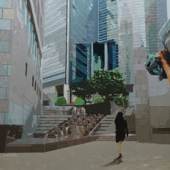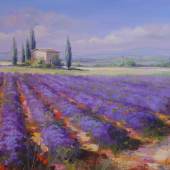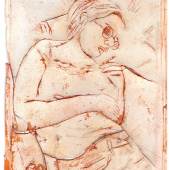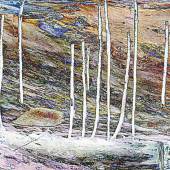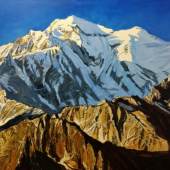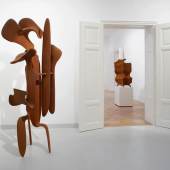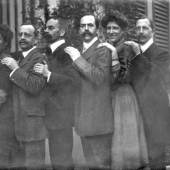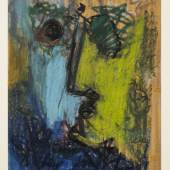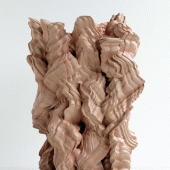TONY CRAGG | Inhabitants: Sculpture
-
Ausstellung11.09.2020 - 17.10.2020
Tony Cragg’s sculpture offers a fascinating mixture of order and disorder, balance and imbalance, method and madness, encouraging us to think about our place in the world and what lies beneath. — Jon Wood
This September, Galerie Thaddaeus Ropac will present a solo exhibition of new works by Tony Cragg (b. 1949), one of the world’s most distinguished contemporary sculptors, exploring the complex relationships between the natural and material world to create a new sculptural language. The exhibition Inhabitants: Sculpture in the Paris Marais gallery will feature a dozen sculptures in bronze, wood and steel, made between 2018 and 2020. These new works connote the movement, change and transience of elements caught in the process of transformation. In recent years, heads and faces have made recurring appearances as leitmotifs in Cragg's work. A circular form appears to morph, shaping the rhythm of the sculptures on display. Overlapping, layered structures and convoluted forms give rise to figurative landscapes that, while inherently physical forms, also map out their vacant spaces, becoming at once positive and negative structures in space.
Cragg's sculptural practice was originally informed by English Land Art and Performance Art, and is distinguished by an ongoing experimentation with formal inventions and combinations. Cragg considers himself a radical materialist, constantly seeking to explore and expand the possibilities of new materials. He has frequently applied techniques such as stacking and layering to different types of waste material, interpreting everyday objects in unexpected ways. In the works in Inhabitants: Sculpture, the artist continues this exploration primarily through steel, bronze and wood, used to create unique, almost geologically layered sculptural forms. Cragg develops these forms from ‘artistic sediments that appear to arise from different eras’, as art historian Eva Maria Stadler describes. The implied motion of these biomorphic forms is reminiscent of Italian Futurist speed fanatics such as Umberto Boccioni (1882–1916) and Giacomo Balla (1871–1958), while the verticality of his pillar-like sculptures recalls Constantin Brâncuși (1876–1957), who similarly arrived at a reduction of the natural form through his unique approach to abstraction.
It’s not so long ago that all sculpture tried to imitate – to copy – nature. We have come a long way in the last one hundred years, but in my view we’re still right at the beginning. — Tony Cragg
Cragg’s primary interest in making sculpture has never been to copy from nature or to represent something that already exists in the world, but rather to discover the ideas and emotions that different materials and forms can evoke. The micro and macro structures afforded by nature have been a major inspiration to the artist over the past ten years.
The distinctive movement and energy of Cragg’s works was described by art historian Jon Wood in 2019: ‘Cragg uses the solidity of sculpture to shape, structure and describe this fluidity and the complicated spatial-temporal movements at stake, in which forms extend, stretch, rotate and spin. Potential energy abounds in his works, as they remind us that all is ultimately moving, seething and active in the world and that nothing is really static.’
Hollow Head (2019) belongs to a series of works that are the result of subtracting one sculptural form from another. The two works entitled Pair (both 2019) – one composed of wood, the other of stainless steel – each consist of two free-standing elliptical columns. The tense relationship between these forms led Cragg to superimpose sculptural volumes inside one another. In doing so, he has created sculptures that infer specific internal boundaries, at times supplementing or subtracting from one another. In Frequencies (2019) expresses the interrelationship between different modes of thought as a form of topography. Of his Skulls series, also on view, Cragg explains, ‘Any impression of solidity is an illusion. This applies as much to aspects of our physical reality as to sculptural traditions. These skeletal volumes reveal their inner structures and leave the viewer with no illusions’. Cragg’s recent Stacks (2018) represent the continuation of a theme he first explored as a student at the Royal College of Art, creating earthy accumulations of discarded materials that have since developed into sleek columnar forms in wood, stone, bronze and steel. The exhibition will also include a monumental wooden work from the In No Time series (2019), an overwhelming, emotionally charged structure that is reminiscent of geological phenomena.
Artworks are the result of the experiences that artists have had while making the work and showing it to others is an offer to share that experience of adventure and discovery. It is comparable in some ways with visiting an undiscovered landscape, encountering a new species, or even with learning a new fact of physics. Art shows us who we are and where we stand. Ultimately all art, no matter how abstract, revolves around and relates to the human figure and human nature. — Tony Cragg
ABOUT THE ARTIST
-
21.03.2024 - 11.05.2024Die Ausstellung präsentiert neue Arbeiten von Tony Cragg. Die Skulpturen des britischen...
-
Umbau in der Villa Flora – Wiedereröffnung 2024Besuchen Sie unsere Veranstaltungenin und um...
-
21.03.2024 - 11.05.2024Die Ausstellung präsentiert neue Arbeiten von Tony Cragg. Die Skulpturen des britischen...
-
21.03.2024 - 11.05.2024Die Ausstellung präsentiert eine Serie von Zeichnungen und Keramikarbeiten des israelischen...
-
11.09.2020 - 17.10.2020
Galerie Thaddaeus Ropac
7 rue Debelleyme, 75003 Paris
Opening hours
Tuesday – Saturday, 10am – 7pm
